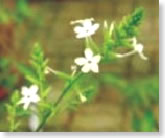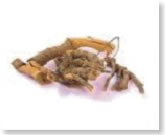
CHITRAKA
Botanical Name: Plumbago zeylanica (PLUMBAGINACEAE)
English Name: Leadwort
Hindi Name: Chitrak, chita

Introduction: This herb is known to Indian Medicine for times immemorial. Interestingly, it is a fore-bidden leafy vegetable as per Vaikhanasa Dharma Sutra (3/5/8). Charaka described it as one of the best cures for proctitie, piles & abdominal colic. Susruta considered it as anti-oxidant ( Rasayana). There are another two varieties viz. red (P. capensis) varieties. Red variety was used for converting mercury to gold. This variety is even considered good for human health and recommended as tonic. Chitrak is an ingredient among Trimada, Panchakola & Shadushana.
Distribution: Found throughout India upto 4500 feet in the hills. Cultivated in gardens mainly.
Chemical Constituents: Chitranone, plumhagin, 3-chlorplumbagin, zeylanone & zeylinone, isozeylinone, plumbagic acid etc.
Parts Used: Root
Properties: Acrid, hot, corrosive, appetizer, digestive, cholesterol reducing, anti-cancer etc.
Indications: Piles, digestive disturbances, obesity/ excess cholesterol, skin diseases etc.
Dose: Root powder 1-2g/day
Therapeutic Uses:
- Piles: Chitraka and dry ginger are made as paste with beer and applied externally.
- Indigestion: 1-2 g powder of Chitraka with honey water before food.
Scientific Studies:
Safety studies: LD50 & LD50 of AE(50%) of roots was 500mg/kg i.p. in albino mice (Bhakuni et al., 1969) and 1000mg/kg.i.p. (Sharma et al., 1978) respectively.
Anti-cancer activity: Plumbagin administered intratumorally and orally at 2 mg/kg b.w. decreased tumor growth by 70% and 60% respectively in rats methylcholanthrene- induced tumors. Plumbagin was active against P388 lymphocytic leukaemia at 4 mg/kg (Ind. J. Exp. Biol. 1980, 18, 876).
Anti- coagnulant activity: Plumbagin significantly increased prothrombin time, total proteins, GPT and ALP levels in liver and decreased GPT levels in serum in rats (Santhakumari et al., 1978).
Lipid Lowering Effect: Plumbagin reduced serum cholesterol by 53.0 to 86.0% and LDL- cholesterol by 61.0 to 91.o%in rabbits ( Ind. J. Pharmacol., 35(10). 1991).
Anti-pyrtic activity: 50% AE of roots showed hypothermia and antagonism to amphetamine hyperactivity in mic ( Bhakuni et al., 1969).
Anti-ovulatory activity: Plant extract (100 mg/kg) prevented 100% ovulation and implantation in female rats ( J.Res. Ind. Med. 1971, 6, 172).
Cultivation Technology: This plant is cultivated in sandy-loam soils. Seeds are sown in nursery beds in the month of March-April. It can also be propagated through stem cuttings. 8-10cm long stem cuttings with at least 2-3 internodes are planted in poly-bags in June-July. Seedlings of 10-15cm length are transplanted on ridges at the distance of 30x30 cm in July-August. Irrigate the field after planting and later as and when required.
Harvesting: Seeds can be collected during October-November. Roots are collected after 2-3years of plantation, in winter.







